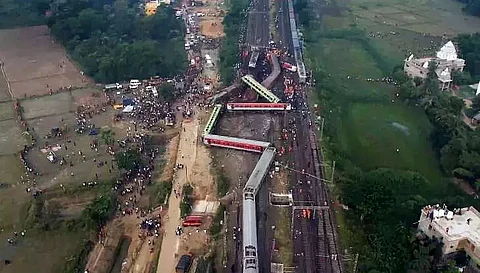
- Home
- Live Blog
- Breaking News
- Top Headlines
- Cities
- NE News
- Sentinel Media
- Sports
- Education
- Jobs

BALASORE: On Sunday, the 275 people dead and more than 1,100 injured in the terrible train disaster in Odisha's Balasore district were examined by the minister of railways, Ashwini Vaishnaw. One of the deadliest rail accidents to occur in India in almost three decades was the collision of three trains.
Over 1000 people are working tirelessly at the accident site while being constantly monitored by the railway authority.For immediate repair, more than seven Poclain machines, two accident relief trains, and three to four railway and road cranes are now in use.
The triple train accident's "root cause" and those accountable have been found, according to the Railway Minister's statement on Sunday following the examination. Vaishnaw said that all bodies had been removed from the accident site and that repair work was still in progress.
"The root cause of this accident has been identified. PM Modi inspected the site yesterday. We will try to restore the track today. All bodies have been removed. Our target is to finish the restoration work by Wednesday morning so that trains can start running on this track," he said.
“The commissioner of railway safety has investigated the matter and let the investigation report come but we have identified the cause of the incident and the people responsible for it... It happened due to a change in electronic interlocking. Right now our focus is on restoration,” said Vaishnaw.According to him, a change in electronic interlocking was what caused the catastrophe.
Around 2,500 passengers on two passenger trains—the Bengaluru-Howrah Superfast Express and Shalimar-Chennai Central Coromandel Express—and a goods train were involved in a crash on Friday around 7 PM near the Bahanaga Bazar station in Balasore, which is located about 250 kilometres south of Kolkata and 170 kilometres north of Bhubaneswar.
Numerous passengers were trapped when twenty-one carriages derailed, suffered significant damage, and were severely injured. Experts have noted the high speed of both passenger trains as one of the primary causes of the significant number of fatalities.
A signal was provided to Coromandel Express to enter the main line, but it was disregarded, causing the train to enter the loop line and crash into a cargo train that was stopped there, according to preliminary findings into the railway accident. High-speed Coromandel Express coaches that were dispersed on the next track were struck by the Bengaluru-Howrah Superfast Express.
Investigators were looking into any instances of human error, signal failure, and other potential factors earlier on Saturday.
According to officials, the Indian Railways has launched a high-level investigation into the tragedy, which will be overseen by the South Eastern Circle's commissioner of railway safety. Railway officials stated it is still unclear if Coromandel Express entered the loop line and struck the halted goods train or if it first derailed and then struck the parked train after entering the loop line, despite earlier reports that a signalling malfunction may have caused the collision.
ALSO WATCH: